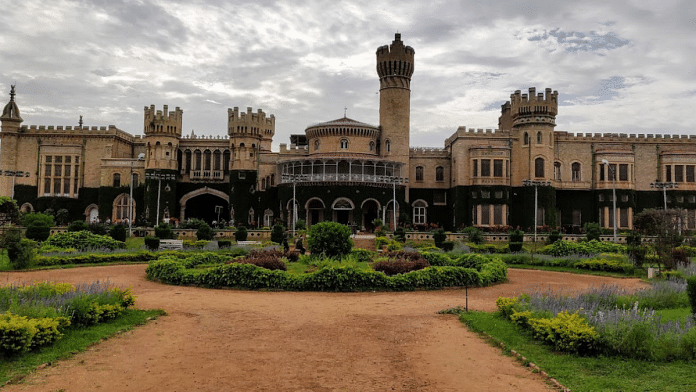Bengaluru: Former Prime Minister H.D. Deve Gowda gave a passionate speech in the Rajya Sabha Monday, praising the erstwhile royal family of Mysore’s contribution in constructing a meter-gauge railway line in Karnataka.
Even as Gowda was speaking in the national capital, the Upper House of Karnataka’s legislature passed a bill effectively denying the erstwhile royals any claim to properties owned by them until at least 1996, including a sprawling 472-acre parcel of land in the heart of Bengaluru.
The Karnataka Legislative Council passed The Bangalore Palace (Utilization and Regulation of Land) Bill, 2025, reintroducing legislation first mooted in 1996, which reaffirms the government’s ownership of the Bangaluru Palace grounds. According to the bill, acquiring the land for any developmental purpose has nothing to do with the erstwhile royal family.
The bill’s objective, according to the government, is to regulate the use of the Bangalore Palace land, which was acquired under the Bangalore Palace (Acquisition and Transfer) Act, 1996 (Karnataka Act 18 of 1996). The Siddaramaiah-led Congress government argues that the state of Karnataka legally owns the land, which was bought for a paltry sum of Rs 11 crore in 1996—roughly translating to around Rs 2.70 lakh per acre.
Also Read: Jayachamarajendra Wadiyar was a ‘maverick maharaja’ who ruled Mysore—and the world of music
Who are the Wadiyars of Mysore
The erstwhile royal family of Mysore belongs to the Wadiyar dynasty founded by Yaduraya which ruled from 1399 to 1947.
Initially serving as vassals and then as viceroys to the Vijayanagara Empire, the kingdom first wrested control over Srirangapatna and then continued to expand across the Deccan.
With the disintegration of the Vijayanagara Empire in 1565, the Wadiyar dynasty expanded its boundaries, establishing a reign considered among the most progressive in Karnataka’s history.
In the 1700s, this kingdom was taken over by Hyder Ali and later his son, Tipu Sultan, for nearly half a century. But after Tipu Sultan’s defeat and death in the fourth Anglo-Mysore war, the Wadiyars regained control with the help of the British.
This period is considered among the golden eras of Karnataka’s history with the setting up of educational institutions, cultural significance and progressive laws.
Srikantadatta Narasimha Raja Wadiyar has served as an MP four times. His son, Yaduveer, is currently the BJP MP from Mysuru-Kodagu.
At the time of Independence, the country had 562 princely states that occupied nearly half of the land mass and ruled over nearly a third of the population.
Most of them were given the choice to join India or Pakistan or remain independent. The princes were assured that they would continue as rulers of their territories except in three departments: defence, foreign affairs and communications. These princes were given privy purses or annual payments to unite with India, a practice protected by the Constitution until its abolition in 1971 through the 26th Amendment.
In Karnataka, the government then started aggressively acquiring several properties belonging to the erstwhile royal family, including many temples.
“Majority of the lands the family held, these were private properties of the maharaja in 1949-50. The maharaja was asked for his private properties and the Government of India accepted this list,” said one member of the erstwhile royal family, requesting anonymity.
What is Bangalore Palace acquisition bill
On 21 November 1996, the then-Karnataka government enacted the Bangalore Palace (Acquisition and Transfer) Act. Two years later, the government brought in a similar bill to take over the Mysore palace and properties.
In both cases, the erstwhile royal family challenged this in the courts.
Members of the erstwhile royal family said that the property title and possession remain with them but the government claims that it already owns all of these lands.
Around 1999, proposals to widen the road around the palace grounds reignited a court battle that continues to this day. The road-widening project, aimed at decongesting the area, would require over 15 acres of land around the palace.
However, with land acquisition being an expensive proposition in cities like Bengaluru, the Transfer of Development Rights (TDR)—allowing landowners or builders to construct over and above the permissible limit—was seen as the solution.
The family said they asked for TDR certificates which would not have any impact on the exchequer since these certificates could be sold to builders. But the government believed the land belonged to it and there was no question—or need—to pay anyone else.
In December 2024, the Supreme Court gave its verdict in a contempt case, directing the state government to issue TDRs to the family. In January this year, the Karnataka government promulgated an ordinance to avoid issuing the TDR which was then replaced with the bill tabled in the ongoing budget session of the state legislature.
Members of the erstwhile royal family alleged the Siddaramaiah-led government has been targeting it even though earlier governments of the Bharatiya Janata Party (BJP) or other parties too have not backed down from claiming these properties as state-owned.
BJP leaders, led by its state president B.Y. Vijayendra and Deputy Leader of the Opposition Arvind Bellad, staged a walkout when the bill was presented in the Assembly last week.
The state cabinet approved the bill Thursday. However, the Supreme Court mandated that the Karnataka government deposit over Rs 3,000 crore worth of TDR certificates with it, which cannot be used until the final court order. The final court verdict is awaited.
(Edited by Sugita Katyal)
Also Read: ‘Tipu’s drop’, the cliff where Mysuru people were pushed to death under Tipu Sultan’s reign







Irony of it is it was HDD who piloted the Bangalore Palace( Acquisition & Transfer) Bill, 1996 when he was the CM and the Bill received the assent of the president when he was the PM !